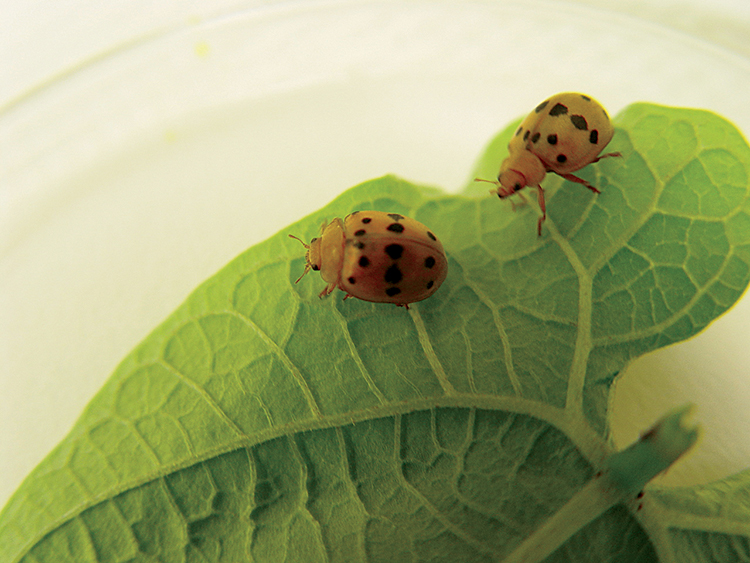Home > New Jersey > New Jersey Ag Education > Bugs to the Rescue
Bugs to the Rescue

When it comes to the advantages of beneficial insects in New Jersey, most farmers and growers are especially interested in the bottom line. The research being done at the Phillip Alampi Beneficial Insect Rearing Laboratory helps to control many different species of detrimental insects and weeds. In the 30 years since the laboratory was established, the staff has developed a cost-effective method of using “good” insects to populate fields, gardens and forests, as well as reduce the use of pesticides.
As a result, farmers and growers are seeing benefits to their profits. In fact, the New Jersey Department of Agriculture (NJDA) has written a report that shows a savings of over $101 million annually on pesticides.
“Our goal is not to eradicate. We’re trying to suppress weed and insect populations to a manageable level,” says Tom Dorsey, director of the laboratory. “They not only have environmental benefits, but they also save farmers and growers tremendous amounts of money that they would use on pesticides.”
Small Staff, Many Insects
The NJDA’s Division of Plant Industry opened the 21,000- square-foot Phillip Alampi lab in 1985 to allow state entomologists to develop insect-rearing techniques for use in dispersing insects into fields and forests across the state. Within the lab’s center section are 30 environmentally controlled insect-rearing rooms that can simulate any season or time of day. Most of the rooms are used for development and implementation of biological control programs.
“The lab came about because of a strong push from a past agriculture director named Phillip Alampi,” Dorsey says. “He had a strong belief in biological control, and convinced state legislators that this would be something beneficial to the state and cost-effective.”
![New Jersey Beneficial Insect [INFOGRAPHIC]](https://eadn-wc01-4177395.nxedge.io/wp-content/uploads/2020/05/Screen-Shot-2014-11-06-at-4.06.05-PM.png)
The staff is relatively small, Dorsey says, considering the hundreds of thousands of insects that come out of the lab. It includes entomologists, lab technicians and lab service workers. Mark Mayer is field supervisor for the program.
“We have three full-time field people,” Mayer says. “Our job is to deliver the beneficial insects to the targets at the proper time and make sure we have enough so the insects either establish or, in the case of the Mexican bean beetle program, are released in strategic areas.”
Success Stories
The Mexican bean beetle program is one of the higher-profile projects of the beneficial insect program. To help control the pest that harms primarily soybeans, but also snap and lima beans, the lab has used a beneficial parasitoid for a number of years. The result has been an annual savings of more than 100,000 acres of soybeans and a reduction of pesticides by more than 21 tons.
Dorsey and his staff have partnered with the U.S. Forest Service and the Connecticut Agricultural Experiment Station to help control the hemlock woolly adelgid, a pest that feeds on the sap of the hemlock tree and can kill the tree within three years. The beneficial insect lab continues to rear predators to help protect hemlock stands.
The lab is also researching and implementing insects to battle the mile-a-minute weed, named for its ability to grow rapidly and shade out native plants. It can be a problem for Christmas tree farms. The NJDA rears a tiny weevil that specifically feeds on the mile-a-minute weed.
“We have very diverse programs that cover the whole scope,” Dorsey says. “We’ve become a reliable source of beneficial insects for a number of states.”



